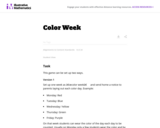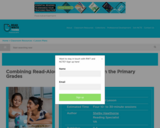
Coloring sheets provited by NASA.
- Subject:
- Astronomy
- Science
- Material Type:
- Activity/Lab
- Provider:
- NASA
- Provider Set:
- STEM Outreach
- Author:
- NASA
- National Aeronautics and Space Administration
- Date Added:
- 06/08/2023

Coloring sheets provited by NASA.

Using different writing/drawing materials (e.g., markers, color pencils, pastels, etc.), students learn how to communicate different moods and/or feelings to support their written ideas and how authors do the same through their work.

Students use their five senses as a prewriting tool to guide their poetry writing as they compose free-form poems using imagery to describe a color.

The purpose of this task is to help students understand the connection between counting and cardinality. Thus, oral counting and recording the number in digit form are the most important aspects of this activity. However, teachers can extend this by making a bar graph about how many students are wearing the color each day.

Poppy Wreath for Remembrance Day-printable colouring page

Pat Mora's poem "Echoes" demonstrates that our senses are powerful tools for literary analysis and comprehension as students use their senses to discover new ways to read and write.

This is an activity about the electromagnetic spectrum and how light is split into its component frequencies or colors. Using a diffraction grating, learners will observe four different light sources and sketch their spectra. This activity requires access to a sodium vapor or mercury vapor light and two neon signs of differing color, as well as diffraction grating material. This is Astronomy Activity 2 in the Space Update collection of activities.

This art history video discussion looks at the Colosseum (Amphitheatrum Flavium), c. 70-80 C.E., Rome.

This video features a Smarthistory conversation between Dr. Beth Harris and Dr. Steven Zucker in front of the Colossus of Constantine, c. 312-15 (the first Christian Emperor of Rome). Palazzo dei Conservatori, Musei Capitolini, Rome.

Science Background:
When a metal or metal salt is burned, the input of thermal energy raises the electrons in the metal atom to a higher energy state. These electrons cannot remain in this excited state for too long and will emit energy in the form of light to return to the more stable, grounded state. It is this light we see when a metal atom is burned in a flame. Each metal has a characteristic flame colour which has been found to be useful in identifying minerals.
Materials: wood splints, Bunsen burner or BBQ lighter, solutions of strontium chloride (red), cupper (II) chloride (blue), copper (II) sulphate (green), calcium chloride (orange), potassium chloride (purple), and sodium carbonate (yellow).

The importance of family is prominent throughout the works, The vibrant colours represents the joy of life, it is meant to inspire hope, success, and happiness. These paintings are a tribute to my late mother who was my guide throughout my life, my late Grandmother for her strength in cultural beliefs and traditions, and my children for the inspiration they give me, Meegwetch.
- Kevin Peeace

Jason Logan is a Toronto-based artist, inkmaker and forager. He began his career as an illustrator in New York City and became interested in natural sources of pigment when his children were born. This documentary, organized by colour, takes us into Jason’s world, highlighting his curiosity, spirit of experimentation and creativity as he gathers natural and botanical materials throughout his travels and transforms them into ink, working like a mad scientist of sorts. For Jason, the creation of ink becomes a vehicle for connecting and relationship building with artists and other creatives from around the world. This mini lesson invites students to analyze where art materials come from by looking at the impact of drawing on the natural world to make ink. They will also explore concepts of permanence and ephemerality and can engage in geographically tracking the movement of Logan’s inks from place to place. The mini lesson also creates opportunities for students to research an individual artist represented in the film, and finally to work in pairs to make ink for one another.

Over the last four episodes, we’ve examined some of the stories that make up the idea of a “revolution” in knowledge-making in Europe. But we can’t understand this idea fully, without unpacking another one—the so called Age of Exploration. This encompasses a lot of events that happened from 1400 through the 1600s and were driven in part by new ideas about knowledge-making.

In which John Green teaches you about the changes wrought by contact between the Old World and the New. John does this by exploring the totally awesome history book "The Columbian Exchange" by Alfred Cosby, Jr. After Columbus "discovered" the Americas, European conquerors, traders, and settlers brought all manner of changes to the formerly isolated continents. Disease and invasive plant and animal species remade the New World, usually in negative ways. While native people, plants, and animals were being displaced in the Americas, the rest of the world was benefitting from American imports, especially foods like maize, tomatoes, potatoes, pineapple, blueberries, sweet potatoes, and manioc. Was the Columbian Exchange a net positive? It's debatable. So debate.

In which John Green teaches you about the beginning of the so-called Age of Discovery. You've probably heard of Christopher Columbus, who "discovered" America in 1492, but what about Vasco da Gama? How about Zheng He? Columbus gets a bad rap from many modern historians, but it turns out he was pretty important as far as the history of the world goes. That said, he wasn't the only pioneer plying the seas in the 1400s. In Portugal, Vasco da Gama was busy integrating Europe into the Indian Ocean Trade by sailing around Africa. Chinese admiral Zheng He was also traveling far and wide in the largest wooden ships ever built. Columbus, whether portrayed as hero or villain, is usually credited as the great sailor of the 15th century, but he definitely wasn't the only contender. What better way to settle this question than with a knock-down, drag-out, no holds barred, old-fashioned battle royal? We were going to make it a cage match, but welding is EXPENSIVE.

This art history video discussion examines the Column of Trajan, Carrara marble, completed 113 C.E., Rome. Dedicated to Emperor Trajan (Marcus Ulpius Nerva Traianus b. 53 , d. 117 C.E.) in honor of his victory over Dacia (now Romania) 101-02 and 105-06 C.E.

The primary purpose of this problem is to rewrite simple rational expressions in different forms to exhibit different aspects of the expression, in the context of a relevant real-world context (the fuel efficiency of of a car). Indeed, the given form of the combined fuel economy computation is useful for direct calculation, but if asked for an approximation, is not particularly helpful.

Students learn that what you read in books can really add up when they analyze literary texts for economic concepts.

This short video and interactive assessment activity is designed to teach fourth graders about combining units using addition and subtraction (metric units).

As a class, students use a low-cost air quality monitor (a rentable “Pod”) to measure the emissions from different vehicles. By applying the knowledge about combustion chemistry that they gain during the pre-activity reading (or lecture presentation, alternatively), students predict how the emissions from various vehicles will differ in terms of pollutants (CO2, VOCs and NO2), and explain why. After data collection, students examine the time series plots as a class—a chance to interpret the results and compare them to their predictions. Short online videos and a current event article help to highlight the real-world necessity of understanding and improving vehicle emissions. Numerous student handouts are provided. The activity content may be presented independently of its unit and without using an air quality monitor by analyzing provided sample data.